Cishan Ice Factory: Birthplace of Crystal-clear Ice/旗山製冰廠 產製晶瑩剔透的冰塊
Cishan Ice Factory: Birthplace of Crystal-clear Ice
◎English translation: Peng Hsin-yi
◎Photos by Pao Chung-hui
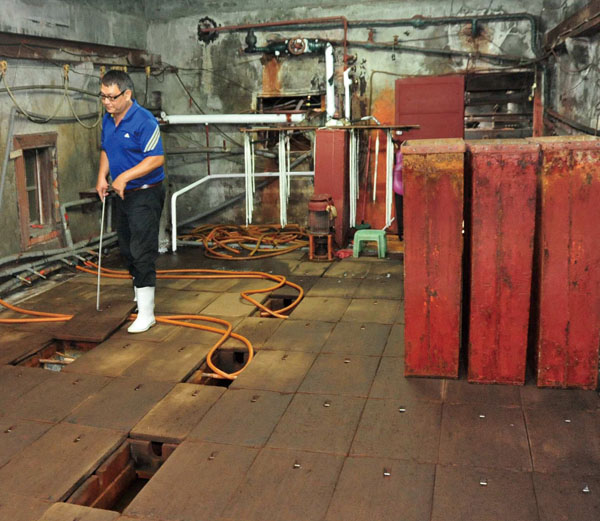 Located in one of the 18 brick buildings on Cishan's Old Street, the unassuming facade of Cishan Ice Factory easily escapes the attention of those passing by. Having been in business for 85 years, the factory today produces ice using the exact same method as when it was established in 1929. Manager Mr. Wu Gui-jhong says the ice business does not make large profits, and most of the earnings come during the busy summer season. The income is enough to keep the factory running through the slow winter months while supporting his family. The old ice factory has a strong reputation for quality and service. Consequently, it enjoys the patronage of local fishmongers, restaurants, and caterers.
Located in one of the 18 brick buildings on Cishan's Old Street, the unassuming facade of Cishan Ice Factory easily escapes the attention of those passing by. Having been in business for 85 years, the factory today produces ice using the exact same method as when it was established in 1929. Manager Mr. Wu Gui-jhong says the ice business does not make large profits, and most of the earnings come during the busy summer season. The income is enough to keep the factory running through the slow winter months while supporting his family. The old ice factory has a strong reputation for quality and service. Consequently, it enjoys the patronage of local fishmongers, restaurants, and caterers.
Back when Cishan Ice Factory was first established, it was considered a fashionable business. Cishan was a transportation hub connecting the coast to the mountainous interior. Refrigeration was not as commonplace as today, so ice blocks were a necessity for those who wanted to keep their food and beverages chilled when traveling to mountain areas. When the railroad was extended to connect Cishan to what is now Kaohsiung's Dashu district, the ice business went as far as the railroad reached. It was the heyday of the ice business. Mr. Wu says that, back then, almost every fishing port had a nearby ice factory. Today only a few of them remain, and the only reason they produce ice is to keep fish fresh.
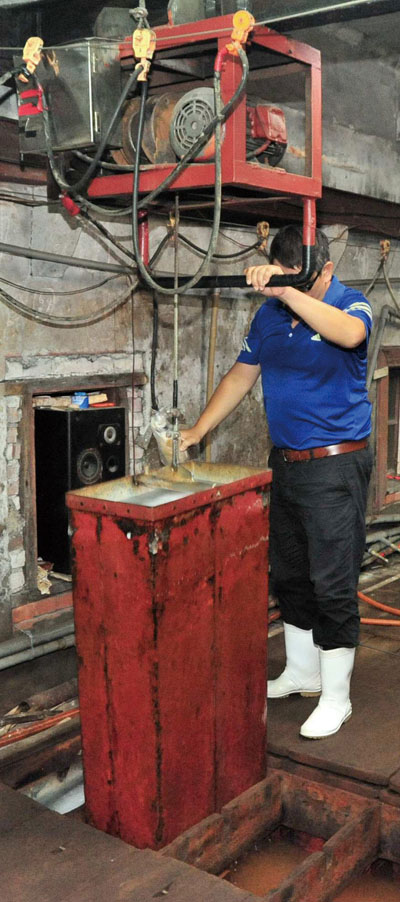
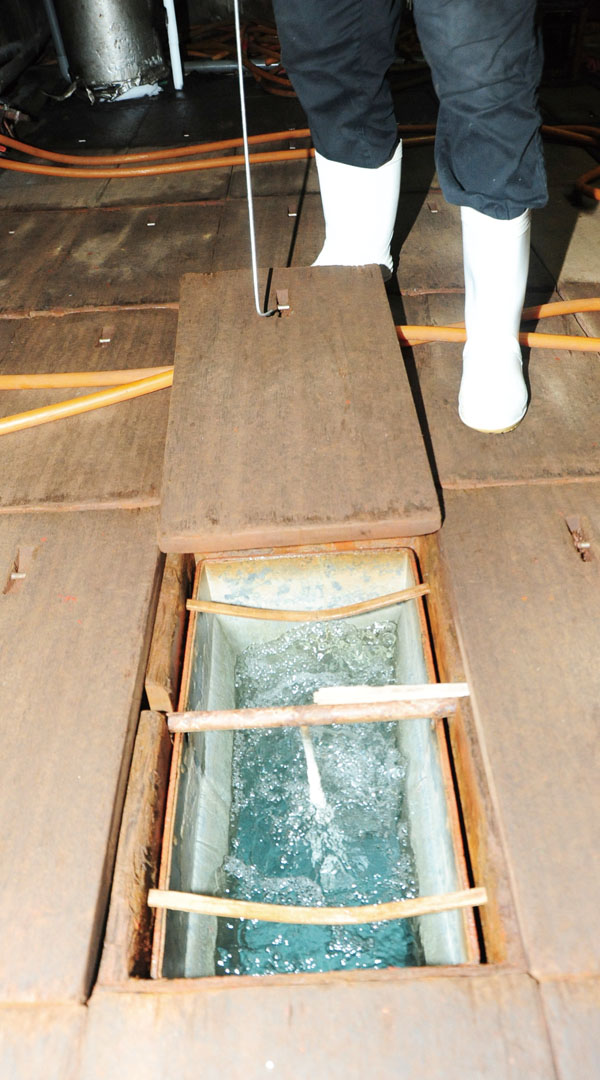 Stepping into the ice factory, one sees rows and rows of ice tanks covered by wooden planks. Mr. Wu says this gigantic refrigerator is manually controlled; there is a grid of ammonia tubes running in the saltwater base beneath the tanks, and a motor pump keeps the saltwater in circulation so as to distribute the coldness evenly. The temperature of the whole ice tank area is kept between -7 degrees Celsius and -13 degrees Celsius (19.4 to 8.6 degrees Fahrenheit). It should not go lower, otherwise the ice blocks will crack. The water is extracted from 40 meters (43 yards) underground, and poured into the tanks from the top. Underground water produces cleaner ice with greater hardness and density, which means the blocks melt more slowly. During the production process, an air tube pumps air slowly into the ice to create the distinctive crystalline look. An ice block starts to form from the edge and slowly forms in the center. That is when the air tube is pulled out, leaving a white column in the middle where the water did not have any air pumped into it.
Stepping into the ice factory, one sees rows and rows of ice tanks covered by wooden planks. Mr. Wu says this gigantic refrigerator is manually controlled; there is a grid of ammonia tubes running in the saltwater base beneath the tanks, and a motor pump keeps the saltwater in circulation so as to distribute the coldness evenly. The temperature of the whole ice tank area is kept between -7 degrees Celsius and -13 degrees Celsius (19.4 to 8.6 degrees Fahrenheit). It should not go lower, otherwise the ice blocks will crack. The water is extracted from 40 meters (43 yards) underground, and poured into the tanks from the top. Underground water produces cleaner ice with greater hardness and density, which means the blocks melt more slowly. During the production process, an air tube pumps air slowly into the ice to create the distinctive crystalline look. An ice block starts to form from the edge and slowly forms in the center. That is when the air tube is pulled out, leaving a white column in the middle where the water did not have any air pumped into it.
The factory has 103 tanks, each of which produces a block weighing 144 kg (317 lbs). It takes three days to make a batch of ice. The ice tanks are pulled out by a machine and turned around by a pulley, so the ice slides out while the tank stays in place. The ice block is then slid to the ground floor via a ramp. There, the gigantic blocks of ice are cut into smaller sizes. Mr. Wu secures each chunk with a giant clamp and moves it into a refrigerated storage area. The ice factory's design is so precise it is hard not to be impressed by the wisdom of those who designed it several decades ago.
Ice-making is hard work, Mr. Wu says, and his work environment is an ice box 10 degrees Celsius below zero (14 degrees Fahrenheit). He has to go in and out frequently, as on a hot day his job is to transport these gigantic ice blocks to his customers, regardless whether they need it to chill some food or preserve a whole boatload of fish. However, Mr. Wu loves his job. He has vowed to watch over a factory older than he is, and maintain impeccable quality. Cishan has numerous traditional industries still in existence, passed down by ancestors in much the same way as the ice factory. Local artisans demonstrate their appreciation of the past, their persistent quest for quality keeping such traditions alive for future generations.
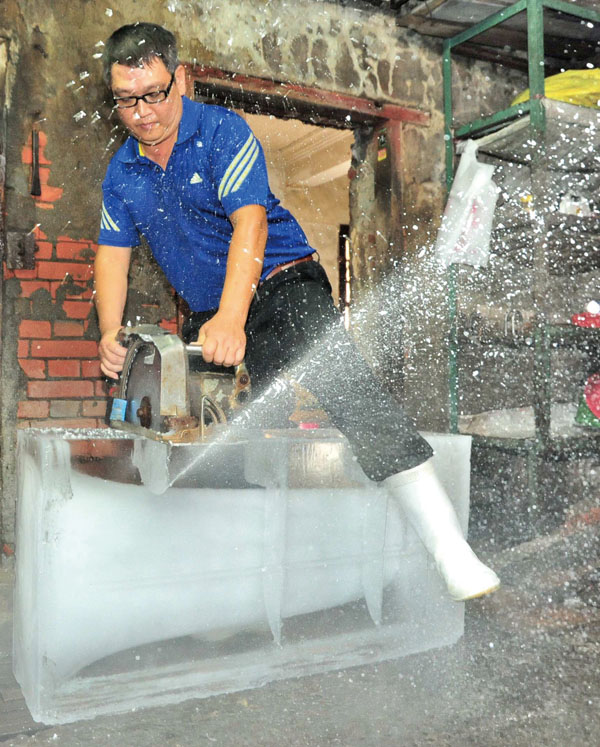 旗山製冰廠 產製晶瑩剔透的冰塊
旗山製冰廠 產製晶瑩剔透的冰塊
◎文/侯雅婷
◎攝影/鮑忠暉
創立於1929年的「旗山製冰廠」隱身於熙來攘往的旗山老街上,是當時旗山老街上18棟磚造建築之一,規劃為專門製冰使用,迄今持續營業,且沿用85年前的傳統古法製冰;經營者吳桂忠表示,製冰是小本生意,夏日營收彌補冬天虧損,足夠養家活口;論品質、服務,老冰廠樣樣出色,當地市場魚販、餐廳或外燴辦桌業者都有忠誠愛用者。
旗山製冰廠成立之際為高雄的新興事業,由於旗山為通往山區門戶,過去農業社會在冰箱尚未普及的年代,冰塊屬於民生必需品,要到山區的人,會至冰廠採購冰塊以保存食物和涼飲;那時旗山築有鐵路通往大樹區,製冰版圖隨之延伸,不難想見製冰業大好光景。吳桂忠談起,彼時台灣鄰近海港或漁港都設有製冰廠,現在部份漁港雖保有製冰廠,但生產用途僅停留在魚肉保鮮階段。
踏進旗山製冰廠冰庫,只見一格格的製冰槽上方蓋著木片。吳桂忠表示,製冰廠採用人工控制這個大冰箱,利用馬達使製冰槽底部的鹽水循環,鹽水裏裝置阿摩尼亞管,整個冰槽的平均溫度為零下7度,最低不超過零下13度,否則冰塊會裂開,透過這樣的裝置於上方製冰槽注入水,使用地下40米的地下水,再透過打氣管將空氣打進去,使冰塊呈現透明狀,水質較乾淨,且硬度、密度都較高,融化速度較慢;整塊大冰塊會從外方先結冰,唯獨打氣管抽離時,無法打氣的部份會呈現白色,其餘有打氣的部份都呈現透明狀。冰廠有103個製冰槽,每個冰槽產製重達144公斤的冰塊,歷時3天方能完成,製出的冰塊呈現美麗的清透樣貌。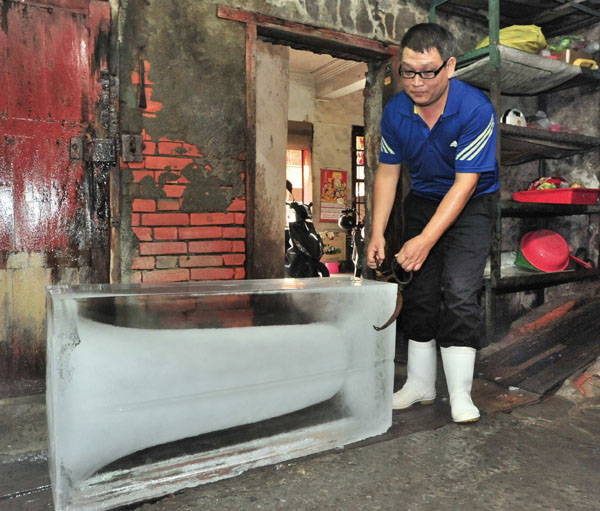 再用機械裝置將冰槽取出,之後把冰筒置於滾動的輪軸,冰筒會被扣住,然而冰塊會順著冰塊坡道滑至1樓;接著便切割冰塊,再用大夾子拖住冰塊,儲存於坡道旁的冰箱。冰廠精準的設計,讓製冰的流程更加順暢而實用,讓人不禁佩服先人智慧。
再用機械裝置將冰槽取出,之後把冰筒置於滾動的輪軸,冰筒會被扣住,然而冰塊會順著冰塊坡道滑至1樓;接著便切割冰塊,再用大夾子拖住冰塊,儲存於坡道旁的冰箱。冰廠精準的設計,讓製冰的流程更加順暢而實用,讓人不禁佩服先人智慧。
吳桂忠說製冰是門粗重的工作,他得在冰箱零下10度的溫度與外頭進出,於大熱天裏奔波運送冰塊至客戶手上,不管客戶購買冰塊是要冰鎮飲料還是保存魚貨,吳桂忠用品質守護這家走過逾一甲子的製冰廠。在旗山,產業和技藝傳承在不同角落不斷上演,不啻是一份對先人的感懷,更是一份堅持美好品質的職人精神。